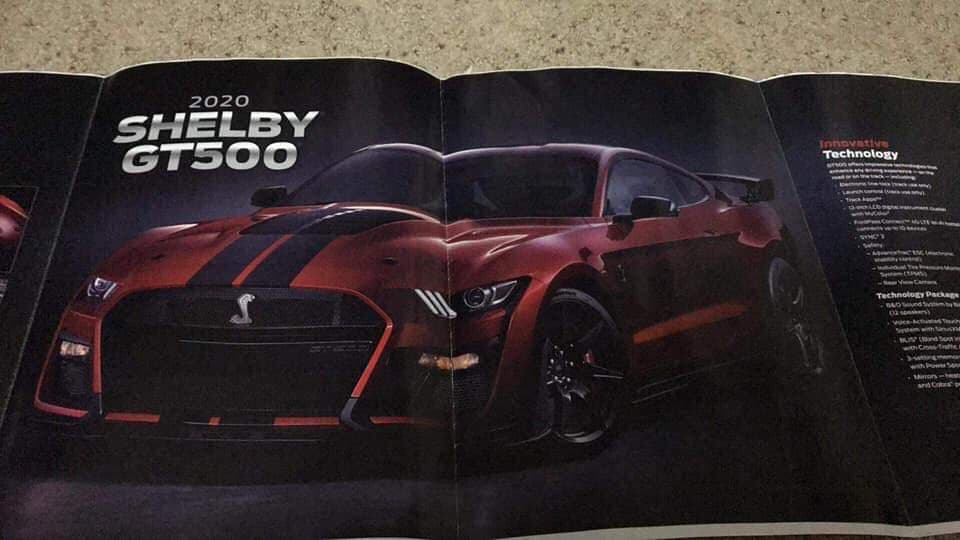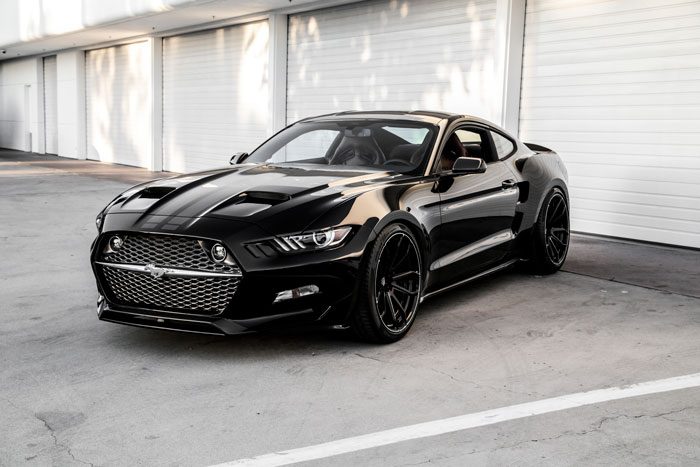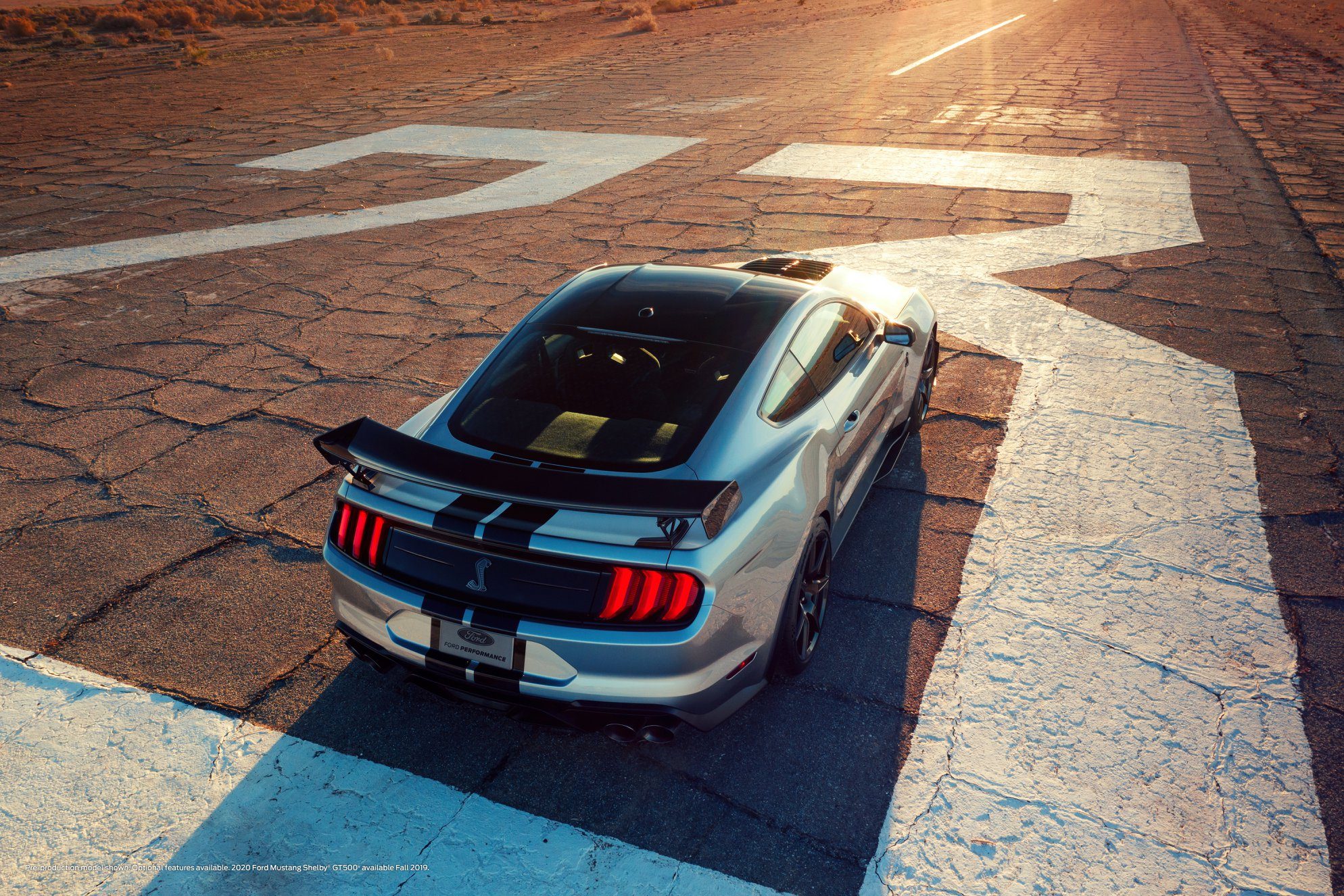You are using an out of date browser. It may not display this or other websites correctly.
You should upgrade or use an alternative browser.
You should upgrade or use an alternative browser.
2015 Ford Mustang - General Discussion
- Thread starter CodeRedR51
- 6,247 comments
- 392,831 views
- 15,315

- TRAPPIST-1g
- ProjectWHaT
Wow look a leak. This time not a Supra 
https://jalopnik.com/2020-ford-mustang-shelby-gt500-this-might-be-it-for-re-1831719283


If it's not legible, it says 5.2L supercharged V8 and a 7 speed dual clutch

https://jalopnik.com/2020-ford-mustang-shelby-gt500-this-might-be-it-for-re-1831719283


If it's not legible, it says 5.2L supercharged V8 and a 7 speed dual clutch
- 11,323

- Marin County
5.2 liters. Hmm. I wonder if it will actually have less power than the old 5.8? That would actually be refreshing.
edit: Nope. Apparently it will have 755hp, which seems like too much.
edit: Nope. Apparently it will have 755hp, which seems like too much.

Last edited:
- 6,877

- Jakarta
Didn't someone leaked the photo of the blue one back then?Wow look a leak. This time not a Supra
https://jalopnik.com/2020-ford-mustang-shelby-gt500-this-might-be-it-for-re-1831719283


If it's not legible, it says 5.2L supercharged V8 and a 7 speed dual clutch
- 22,549

- Arizona
- HamiltonMP427
5.2 liters. Hmm. I wonder if it will actually have less power than the old 5.8? That would actually be refreshing.
edit: Nope. Apparently it will have 755hp, which seems like too much.
Not sure why this was thought to be the case by some, not just yourself. Seeing as they've greatly improved on the supercharger technology since using the 5.8 and everyone close to the horribly kept secret and even in the Ford teaser for the car said it'd be 700+. Though with what I'm seeing for performance the 755 isn't surprising and clearly is Ford trying to target the buying audience for the ZR1, I just hope pricing isn't near ZR1 range.
I'd be interested in seeing how this car stacks up against the GT. I wonder if they were also able to keep the same rev limit and compression ratio with the supercharger, going up 230 hp is quite insane.
CodeRedR51
Premium
- 55,260

- United States
- 11,323

- Marin County
Not sure why this was thought to be the case by some, not just yourself. Seeing as they've greatly improved on the supercharger technology since using the 5.8 and everyone close to the horribly kept secret and even in the Ford teaser for the car said it'd be 700+. Though with what I'm seeing for performance the 755 isn't surprising and clearly is Ford trying to target the buying audience for the ZR1, I just hope pricing isn't near ZR1 range.
I'd be interested in seeing how this car stacks up against the GT. I wonder if they were also able to keep the same rev limit and compression ratio with the supercharger, going up 230 hp is quite insane.
TBH, I've been out of the loop on these kinds of things for a long time. I was a member of svtperformance for a solid 8 years (I still remember being stunned by 620whp Kenne Bell Cobras) but started losing interest after the first GT500 came out. Basically, I haven't been paying attention.
 What supercharger improvements have been made since the 5.8? I thought the TVS back then was pretty advanced, and at 2.3L, pretty damn large too! However 5.8 + 2.3 = 8.1 Liters. 5.2 + 2.65 = 7.85. So the total difference in displacement between the two, if you add their respective superchargers, is pretty small. I'd imagine the bigger difference is the engine itself is much more advanced than the old 5.8.
What supercharger improvements have been made since the 5.8? I thought the TVS back then was pretty advanced, and at 2.3L, pretty damn large too! However 5.8 + 2.3 = 8.1 Liters. 5.2 + 2.65 = 7.85. So the total difference in displacement between the two, if you add their respective superchargers, is pretty small. I'd imagine the bigger difference is the engine itself is much more advanced than the old 5.8.- 17,720

- Florida
- GranTurismo0517
- RandomCarGuy17
I'm going to guess for pricing that this GT500 will be in Hellcat territory and there will probably be dealership mark-ups.
----
Now, I'm more curious on what Ford is aiming for with this GT500. That wing and front splitter is telling me they're wanting to make it a track car like the GT350R. However with the power and extra weight, I just assumed it would be just something to plug down on a drag strip like the Hellcat.
Oh, I just read the car scoops link mentioned a handling package. So, I guess it's aiming towards a track car afterall.
----
Now, I'm more curious on what Ford is aiming for with this GT500. That wing and front splitter is telling me they're wanting to make it a track car like the GT350R. However with the power and extra weight, I just assumed it would be just something to plug down on a drag strip like the Hellcat.
Oh, I just read the car scoops link mentioned a handling package. So, I guess it's aiming towards a track car afterall.
- 15,315

- TRAPPIST-1g
- ProjectWHaT
- 8,698
TBH, I've been out of the loop on these kinds of things for a long time. I was a member of svtperformance for a solid 8 years (I still remember being stunned by 620whp Kenne Bell Cobras) but started losing interest after the first GT500 came out. Basically, I haven't been paying attention.What supercharger improvements have been made since the 5.8? I thought the TVS back then was pretty advanced, and at 2.3L, pretty damn large too! However 5.8 + 2.3 = 8.1 Liters. 5.2 + 2.65 = 7.85. So the total difference in displacement between the two, if you add their respective superchargers, is pretty small. I'd imagine the bigger difference is the engine itself is much more advanced than the old 5.8.
With superchargers, you have to factor in the pulley ratio. These new chargers are kind of a hybrid (not just ordinary positive displacement types) since they have an internal pressure ratio these days, but the principles are still similar.
What more directly determines the effective displacement is the boost level. In the case of the 5.8, it was 14 psi maximum. Atmospheric is 14.7 psi, so the effective displacement at peak boost is somewhere around 11.3 litres. You have to rotate the supercharger just about 5 times per two rotations of the crank to achieve that, so that implies a pulley ratio of about 2.5 (actual is 7.1" / 2.7" = 2.65).
Guesses of in excess of 650 lb.ft of torque for the new engine put boost levels significantly higher: about 18 psi. That would imply a pulley ratio of around 2.25 - 2.4 for a charger of 2.65 litre displacement.
Taken together, this is likely to be a higher revving engine; peak power could be up near 7k rpm.

Last edited:
- 13,153

- GTPlanet
- Street-King-07
- Quattro Saltire
The mouth on the GT500 is as bad as on the Galpin Rocket.

Performance wise I expect it to be ludicrous.

Performance wise I expect it to be ludicrous.
- 2,024

- Azle, Texas, USA
- GTP_KinLM
- KinLM
TBH, I've been out of the loop on these kinds of things for a long time. I was a member of svtperformance for a solid 8 years (I still remember being stunned by 620whp Kenne Bell Cobras) but started losing interest after the first GT500 came out. Basically, I haven't been paying attention.What supercharger improvements have been made since the 5.8? I thought the TVS back then was pretty advanced, and at 2.3L, pretty damn large too! However 5.8 + 2.3 = 8.1 Liters. 5.2 + 2.65 = 7.85. So the total difference in displacement between the two, if you add their respective superchargers, is pretty small. I'd imagine the bigger difference is the engine itself is much more advanced than the old 5.8.
The 5.8 (Trinity? I think it was called that) may have been relatively advanced compared to the SOHC 4.6 available in the normal GT when the Trinity was first introduced as a 5.4. But it was still a dated engine compared to the newer Coyote base by the time it was retired in 2014.With superchargers, you have to factor in the pulley ratio. These new chargers are kind of a hybrid (not just ordinary positive displacement types) since they have an internal pressure ratio these days, but the principles are still similar.
What more directly determines the effective displacement is the boost level. In the case of the 5.8, it was 14 psi maximum. Atmospheric is 14.7 psi, so the effective displacement at peak boost is somewhere around 11.3 litres. You have to rotate the supercharger just about 5 times per two rotations of the crank to achieve that, so that implies a pulley ratio of about 2.5 (actual is 7.1" / 2.7" = 2.65).
Guesses of in excess of 650 lbf.ft of torque for the new engine put boost levels significantly higher: about 18 psi. That would imply a pulley ratio of around 2.25 - 2.4 for a charger of 2.65 litre displacement.
Taken together, this is likely to be a higher revving engine; peak power could be up near 7k rpm.
This new engine is a 5.2. It actually sounds like it’s essentially the 5.2 Aluminator crate motor (A cross-Plane $15,000 forged-internals crate motor version of the “Voodoo” engine in the GT350) which is based on the Coyote 5.0 (the heads, intake manifold, etc can all fit on an existing Coyote 5.0), an engine which can rev notoriously high straight out of the box for a cross plane American V8.
In fact, the limiting factors on the Coyote (aside from running out of power) rev range are the oil pump gears and pulse ring, I believe. Valve float and other issues which plague high revving pushrod engines are largely reduced in this engine, which is partly why the Voodoo 5.2 is able to rev so high without losing much efficiency due to problems like valve float.
The voodoo engine utilized improved parts in both these areas. And with a FPC, a retuned intake manifold, etc. we can see that the engine is very capable of running well over 8,000 RPM.
As somebody who has purchased a “normal” 5.0 Aluminator after throwing a rod in my original engine, I can attest that peak power is very happily nested above 7,000 RPM before the blower runs out of puff (I have the older 2.3 TVS). I know that others have pushed this 5.0 aluminator to well over 1000 WHP, so 750ish crank from a 5.2 version from the factory sounds reasonable, and unlikely to be very unreliable.
I would guess that, on this engine, and with the newer 2650 TVS, peak power is coming quite high in the rev range; this engine will probably feel ‘similar’ to a Voodoo engine with a supercharger on it (albeit lower revs, but still much more peak RPM oriented than something like an LS or LT pushrod engine).
Again, with the newer, larger blower, and with this very strong, very capable, high revving engine, I have no problem believing that it can surpass the Trinity 5.8’s power figures by nearly 100 HP.
Even if it means running a smaller blower pulley, I would like to believe that both the blower and engine internals are more than up to the task.
It also isn’t as simple as “engine size + blower size = overall displacement”. I’m not educated to explain this very well, but I’m sure somebody else on here can. There’s many other factors; how much boost, how well the supercharger flows, IATs, etc. Same as how a bigger turbo is not always better, or else everybody would be running around with 100mm turbos on their Fiesta ST. Again, feel free to tear me apart here, as this is something I’m not as educated on.
For me, my main worry is the transmission. The only experience I’ve had with a Ford DCT is the one in my parents Focus, which will work for 15,000 miles before completely ruining its clutch pack (I believe) and needing to be serviced. This is not an isolated case; all of my friends and acquaintances with newer Focii(?) have had these same issues with their dual clutch. There are many calling for Ford to announce a recall of the part, but at the time there is no updated part to replace it with; only the same, flawed one that comes with the car when purchased.
Of course, this 7 speed is going to be made by (hopefully) different, more inspired people than the one in the focus, and held up to a higher standard too, one would hope. But all I’m saying is, the previous Tremec T56 Magnum was bulletproof, had fantastic feel, and was easy for anybody to get in and shift. Switching to this new 7 speed (not even using the 10 speed auto everybody is raving about) is a bold move.
We will see.
EDIT: just read in full what @Griffith500 explained with the supercharger situation; oh how I wish I was smart enough to break things down like that
 thank you for putting into words what I can only imagine in my head
thank you for putting into words what I can only imagine in my head
Last edited:
- 22,549

- Arizona
- HamiltonMP427
TBH, I've been out of the loop on these kinds of things for a long time. I was a member of svtperformance for a solid 8 years (I still remember being stunned by 620whp Kenne Bell Cobras) but started losing interest after the first GT500 came out. Basically, I haven't been paying attention.What supercharger improvements have been made since the 5.8? I thought the TVS back then was pretty advanced, and at 2.3L, pretty damn large too! However 5.8 + 2.3 = 8.1 Liters. 5.2 + 2.65 = 7.85. So the total difference in displacement between the two, if you add their respective superchargers, is pretty small. I'd imagine the bigger difference is the engine itself is much more advanced than the old 5.8.
As a couple other members noted and gave good insight to, it's not that simple and displacement isn't all that matters. For example you can see it in the new Vette vs. the old ZR1. The engine displacement is the same but the power gains are much greater and still as stable if not more so drive wise over time as the older car. Lobe technology and enhancing has been a key factor in why modern day superchargers are giving out more power and better performance than their predecessors.
EDIT: I also meant to note that the ZR1 vs the current Z06 shows how displacement isn't a factor in power creation. the 2.3 seen on top of the LS9 was somewhat dwarfed by the new LT4 which uses a 1.8. Spins faster uses somewhat more efficient four lobe set up and thus only makes slightly less boost than the previous model but does it faster and more efficiently.
Last edited:
Joey D
Premium
- 46,710

- Boyne Falls, MI
- GTP_Joey
- GTP Joey
This isn't terribly exciting. I wish Ford would just do something crazy and offer up a twin-turbo EcoBoost V8 for the GT500. I mean I get why they don't, it's not exactly worth the money, but still it'd be way more interesting than a supercharged slapped onto a V8.
Oh well, I suspect it'll be running over people are car shows before too long.
Oh well, I suspect it'll be running over people are car shows before too long.
- 2,024

- Azle, Texas, USA
- GTP_KinLM
- KinLM
This is a very anal nitpick, so I won’t tag anybody or make a big deal about it, especially since Ford may have changed the naming for this particular car.
But as far as I know, even though it is a 5.2 V8, it is a Cross-Plane crank in this car, and NOT a Flat Plane Crank.
This would mean that it is NOT a Voodoo engine, as the article on the main page states.
Again, maybe they are officially naming this engine a “Voodoo” as well, but to my knowledge it is quite fundamentally different and I do not believe it shares the same name. But if I’m wrong then I’m happy to admit it.
But as far as I know, even though it is a 5.2 V8, it is a Cross-Plane crank in this car, and NOT a Flat Plane Crank.
This would mean that it is NOT a Voodoo engine, as the article on the main page states.
Again, maybe they are officially naming this engine a “Voodoo” as well, but to my knowledge it is quite fundamentally different and I do not believe it shares the same name. But if I’m wrong then I’m happy to admit it.
- 12,783

- Cambridge
- Moglet85
- Moglet
Love the fact that they brought back Twister Orange from the 1970 model.
I would have to have it in that colour, it's incredible

I love what they've done with the bodywork where the lights meet the fenders on the GT500, the added crease/overlap really makes the front end look more modern. Do they have wider wheel arches or is that an illusion caused by that same shape?
- 34,949

- Indian Falls, NY
- slashfan7964
Definitely my favorite color so far.I would have to have it in that colour, it's incredible
- 27,385

- Toronto
- NewAesthetic
- SlipZtrEm
This is a very anal nitpick, so I won’t tag anybody or make a big deal about it, especially since Ford may have changed the naming for this particular car.
But as far as I know, even though it is a 5.2 V8, it is a Cross-Plane crank in this car, and NOT a Flat Plane Crank.
This would mean that it is NOT a Voodoo engine, as the article on the main page states.
Again, maybe they are officially naming this engine a “Voodoo” as well, but to my knowledge it is quite fundamentally different and I do not believe it shares the same name. But if I’m wrong then I’m happy to admit it.
FWIW, that was supposed to read as "a variation of the Voodoo" and has since been corrected. That's the message I've got so far. 👍
McLaren
Premium
- 44,467

- Texas
Interesting that Ford would not offer a manual option, even if the Dual Clutch is faster & (along with every thing else revealed) shows Ford’s desire to take it track hopping more so than drag racing.
Curious how it drives and if the press tackles the transmission change like the 991 GT3.
Curious how it drives and if the press tackles the transmission change like the 991 GT3.
- 15,315

- TRAPPIST-1g
- ProjectWHaT
Motor Authority actually asked about the dual clutch and they responded:
https://www.motorauthority.com/news...0-doesnt-have-a-manual-transmission-heres-why
Ford spokesman Jiyan Cadiz told Motor Authority the 2020 Shelby GT500 doesn't offer a manual transmission is because Ford doesn't have one that can handle the power the new snake puts out.
The most powerful production Mustang ever will send power to the rear wheels via a 7-speed dual-clutch automatic supplied by Tremec.
Cadiz told Motor Authority that Ford didn't buy another supplier's manual transmission that could handle the power because the dual-clutch automatic shifts faster than any human could. The ultimate production Mustang chases the biggest numbers for now—three-pedal setups don't fit that. At least now.
It also adds development costs to the program, which can add more to the price.
https://www.motorauthority.com/news...0-doesnt-have-a-manual-transmission-heres-why
- 11,323

- Marin County
Motor Authority actually asked about the dual clutch and they responded:
https://www.motorauthority.com/news...0-doesnt-have-a-manual-transmission-heres-why
*Doesn't have manual transmission that can handle the power, claims as reason for not offering manual. Outsources transmission anyway.*
Such a late '10s marketing answer. So sick of the double speak.
- 6,425

- KCCO
I mean, there's a far better answer they supplied which speaks to why they probably won't make one:*Doesn't have manual transmission that can handle the power, claims as reason for not offering manual. Outsources transmission anyway.*
Such a late '10s marketing answer. So sick of the double speak.
because the dual-clutch automatic shifts faster than any human could.
It's not so much they didn't want to make the manual, but rather they wanted to make a faster car. And this isn't exactly a car that the average Mustang consumer will be purchasing either, so there's really no reason as to why they should bother with it in the first place.
Personally, I believe that car companies are reducing options to not have to have such vast quantities of inventory to maintain and produce. Saving costs overall is more important than public opinion, especially when stuff that sells will continue to sell.
- 15,315

- TRAPPIST-1g
- ProjectWHaT
The GT500 has hood pins, because, without them, the hood would lift at speed.
https://www.motorauthority.com/news...ng-shelby-gt500-needs-its-hood-pins-heres-why
https://www.motorauthority.com/news...ng-shelby-gt500-needs-its-hood-pins-heres-why
https://www.motorauthority.com/news...cord-lap-times-with-2020-mustang-shelby-gt500When everything is locked in and finalized Ford has "no plans" to set lap times or break lap-time records with the 2020 Shelby GT500, [Ford Performance boss Carl] Widmann said.
- 6,425

- KCCO
Not a surprise. They didn't publish anything about the GT, so no reason to here either.
Can't really remember last time I saw anyone that cared about the Mustang going around the nurb though.
Can't really remember last time I saw anyone that cared about the Mustang going around the nurb though.
RocZX
Premium
- 8,849

- New York
- 17,720

- Florida
- GranTurismo0517
- RandomCarGuy17
Um, Ford is governing the GT500 to 180mph.
https://www.caranddriver.com/news/a...4h0CCSyx-pwxqwv10gvKYJ8-Z1s54xfPFnUwgYNKVazfo
https://www.caranddriver.com/news/a...4h0CCSyx-pwxqwv10gvKYJ8-Z1s54xfPFnUwgYNKVazfo
Car and Driver:
Dearborn is still mum on nearly every critical specification of its new GT500 other than these: it is Mustang based. It will feature a supercharged 5.2-liter V-8 cranking out at least 700 horsepower. And now, that this, the most powerful production car Ford has ever created, is governed to 180 mph.
If you're a little let down that Joe Walsh's (at least) 39-year-old Maserati will outrun the brand-new Shelby, don't be. The cost associated with engineering a 200-mph car versus a 180-mph car is not insignificant, and it likely allowed for the wiggle room to include such performance-enhancing features as a dual-clutch automatic transmission and a rear wing borrowed from the Mustang GT4 racer. This should make for the most track-capable Mustang of all time and something that should rival the Chevrolet Camaro ZL1 1LE's pony-car record at C/D's Lightning Lap. Also, some of you may recall the mild embarrassment Ford suffered when many media outlets, including us, could not confirm the automaker's claim that the 2013 GT500, with its 662 horses brought to you by a supercharged 5.8-liter V-8, was capable of 200-mph travel.
At top speed, the GT4-borrowed airfoil of the Exposed Carbon Fiber Track package contributes to a net downforce of 461 pounds. A Handling package–equipped GT500, with a Gurney flap attached to its hybrid spoiler-cum-wing "swing," develops 377 pounds of total downforce. The base GT500 gets by with no downforce-aiding elements but the prize of being the quickest GT500 in a straight line, says Ford.
While we fully expect Ford's claims—mid 3.0s to 60 mph and a sub-11.0-second quarter-mile—to prove true, the difference between the base and Track package will likely be very close, as that package also includes carbon-fiber wheels from supplier Carbon Revolution. In our testing, we found the low rotating inertia to be a slight advantage. The front wheels feature a plasma-coated barrel, as they do on the GT350, to reduce the possibility that the front brakes' immense heat will compromise the wheels' integrity. The 20-inch GT500 wheels are also claimed to weigh the same as the GT350's 19s.
Ford utilized 3D printers to cut development time while engineering the front-end package for the GT500. The massive hood vent, which can be removed to maximize downforce, started as a vent the size of an iPad and quickly developed into the size of an iMac. The front splitter wickets, L-shaped add-on strakes to aid net downforce, were also developed in a fraction of the normal time thanks to 3D printing.
Again, the specifics are few and far between with this one. When we know more, we'll be sure to pass the information on. The 2020 GT500 goes on sale this summer.





